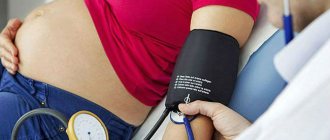Preeclampsia, salt and fluid restriction, the Laman diet, “diuretic herbs” and treatment of edema in pregnant women in the light of modern medical science.
They were afraid of fear where there was no fear (Ps. 13:5).
While on medical business in Germany and Holland, I learned and greatly appreciated one of the principles of training in these countries (training in general and obstetrics in particular). This is “always doubt, check and don’t trust anyone just like that.” Not a textbook, not a teacher, not an authoritative magazine, not a luminary. Study the question yourself and form your own judgment. There are libraries with books and magazines in different languages, the Internet with forums and databases, there are excellent specialists and there is our own common sense. Both in Germany and Holland they teach this from school years. This develops independent thinking and the need for constant learning. If this is not the case, backward and false views and practices will reign for decades.
This is what I mean by all this. Unfortunately, in our Russian community, the habit of checking everything and keeping abreast of modern knowledge is not widespread among obstetricians and parents. Many people also trust authority too much. Just think: we still have both doctors and midwives “treating” edema in pregnant women, believing that this is the same gestosis that is dangerous to the life of the mother and child, and that by removing the edema, they will thereby help the woman. They apparently believe that excess fluid is the root of the problem. Meanwhile, everything is just the OPPOSITE. The whole world has long known that edema in pregnant women is not dangerous and is unreliable as a symptom of pathology, that gestosis can be without edema and then it is much worse, that restricting pregnant women in drinking, eating and salt is not a therapeutic and preventive measure, but a dangerous measure, and therefore , prohibitive diets are not a matter of pregnant bellies.
Why, exactly, should you believe this? That's right, you don't have to believe, you just need to understand the physiology. That is, to understand how the body works and how it works and by what mechanism the disease develops. Then you yourself will figure out what is good and what is bad.
Recently, a panel of reputable physicians reviewed the abstracts of 260 articles published in the American medical journal Surgery, Gynecology and Obstetrics from 1935 to 1999. It turned out that half of the “firmly established medical facts and theories over 45 years have become “mistakes of the past.” Another study examined 474 abstracts of articles on liver disease published in The Lancet and Gastroenterology between 1945 and 1999. And here, too, after 45 years, half of the medical knowledge turned out to be outdated. The famous British neurologist John Hughlings Jackson (1836-1911) once said: “It takes 50 years to drive out a false idea from medicine, but a hundred years to establish a correct one.” "Science and Life" 1/2007
Water is a key element of pregnancy
It is known that the human body is approximately 80 percent water. This means that water is the most important component of our body. During a normal pregnancy, even more water is collected, as much as 6–8 liters, 4–6 of which are outside the body tissues, and 2–3 in the tissues. By the end of pregnancy, about 3 liters of water accumulate in the baby, placenta and amniotic fluid. Another three liters are used to increase the mother’s blood volume, to grow and enlarge the uterus and mammary glands. This is such a flood! Note: this is designed so that there is a lot of water. Whether anyone likes it or not.
The volume of the liquid part of the blood begins to increase very early, from 8 weeks of pregnancy. But, for example, the number of red blood cells is only from 18 weeks. It seems that fluid accumulation is a phenomenon of paramount importance, since the body begins to deal with it so early. And it’s true: after all, how liquid and fluid the blood is, so quickly it can deliver nutrients for the growth of the child, uterus, and mammary glands. And blood can fill a whole new vascular system only if there is a lot of it.
However, the child’s vascular system and all the water space around him is not filled with maternal blood or plasma. Then where does the child get fluid from?
The placenta is a key character in pregnancy
So, we have come to the most important point in the physiology of pregnancy. From the mother's blood, everything necessary, and first of all water, is obtained by another main character of pregnancy, which is not well known - the child's temporary organ called the placenta.
The placenta begins to form like this. Approximately on the 7th day after conception, after traveling a long way through the fallopian tube, the embryo ends up in the uterus. An embryo is an unborn child in a vesicle, the shell of which is covered with villi. When the vesicle is near the wall of the uterus, it first attaches to it with its villi, and then gets to work: with the villi it rebuilds the vessels of the uterus so that they become dilated, full of blood, and around the villi itself they form a mini-pool of mother’s blood, which is constantly and quickly renewed . In this case, the baby’s blood in the villus and the mother’s blood in the pool do not mix. Much like a germinating seed, its roots absorb water and everything it needs from the soil, but not sand, clay and other large objects. “You provide us with building materials, but we know what and how to build,” both the embryo-child and the seed of the plant seem to be saying.
The seed takes roots from the soil only what it offers it. It cannot cause rain, or turn an underground source towards itself. Not so with the placenta: it is not a simple pump that pumps out what is given. No, she, in the apt expression of Michel Auden, is a “baby’s lawyer,” who, among other things, knows how to intervene in the physiology of the mother’s body and “squeeze” out of it what the baby needs. And if the blood pressure (and it is provided by water) in the placenta and the baby begins to fall, she will do everything to get the necessary fluid.
The placenta grows and develops; its construction also requires nutrients from the mother’s blood, and by 18 weeks its formation is generally completed. That is, by the time the child’s rapid growth begins, there should already be a powerful, functional placenta.
So, let's remember two facts well. First: the amount of water in the mother’s blood determines the amount of water in the child, as well as how well building substances will flow to him. Second: the placenta, as an active organ-advocate of the child, in case of shortage, will manipulate the mother’s body so as to receive enough nutrition and water. Up to conflicts.
Two more important substances are salt and protein.
The reader already understands why a lot of water is needed for a normal pregnancy. Now, in order to understand where and how problems with “water supply” can arise, we need to understand something more from physiology. Water to reach the child must be in the blood, in the vessels (and not, say, under the skin, in tissues, body cavities). What holds it in the vessels? There are two substances that pregnant women and obstetricians need to keep in mind: table salt and the protein albumin. If there is a shortage of them, water will leak from the vessels into the tissues, causing EDEMA. Vessels in this situation are like leaky hoses: no matter how much water you pour in, you won’t get the required pressure, and everything around is wet.
Albumin is synthesized by the mother's liver from the amino acids of the food that the mother eats. Therefore, it is important what she eats and how her liver works. Salt – comes from food, can be stored by the kidneys; salt metabolism is also regulated by certain hormones. Remember from physiology that the volume of the liquid part of the blood begins to increase very early, from the eighth week? Now remember what pregnant women crave during the same period: pickles, sauerkraut, herring, salted tomatoes.
Preeclampsia: dehydration and blood thickening
Now you have all the necessary data to understand what happens during gestosis. There is a conflict between what demands the placenta makes on the mother’s body and what the mother can provide her without harming herself. Three situations are possible:
- the mother’s body does not provide enough nutrients and water, for example, due to poor nutrition and insufficient drinking (including non-physiological diets), liver disorders, defects in the vessels of the uterus or its wall, general diseases);
- the placenta (it refers to the baby’s body) cannot absorb enough of the same nutrients and water (irregular structure of the placenta);
- mixed version - both together.
What is common to all cases is that with gestosis there is always (!) a lack of water and albumin in the bloodstream, that is, dehydration and blood thickening always occur. Due to blood thickening, the pressure in the vessels is insufficient, the blood does not flow fast enough, and the placenta manipulates the mother’s body, causing narrowing and spasm of the blood vessels in her body in order to increase the blood pressure. The pressure increases, and initially more blood flows to the baby. But this same spasm ultimately damages the blood vessels. At the sites of damage, platelets and fibrin threads - blood clotting products - are deposited. This, as well as the thickening of the blood itself and the peculiarities of coagulation during pregnancy, leads to the formation of blood clots (!) in the vessels throughout the mother’s body. Particularly affected are those organs on which the load is increased during pregnancy: the liver and kidneys. Blood thickening also leads to poor nutrition and hypoxia in the child. Good blood supply can be compared to skillfully organized traffic, bad blood supply can be compared to widespread traffic jams, when we say: “Yes... the whole city is at a standstill.” It’s not that it’s standing – it’s moving, but how ineffective! Good blood circulation is like good roads.
So, it’s clear where gestosis causes increased pressure (attempts to maintain nutrition for the child), edema (due to a lack of albumin, water leaks into the tissues) and a large amount of protein in the urine (damaged renal vessels let in what they shouldn’t). It is also clear that those who eat poorly and drink little, and those who have large children, twins, triplets (due to increased needs), will be at risk. By the way, it is a well-known fact that extensive physiological edema often develops in women who carry large children. The first sign of gestosis may be an increase in the amount of hemoglobin in a general blood test after 18-20 weeks of pregnancy. (Normally, hemoglobin should decrease slightly). An increase in hematocrit will be even more eloquent. Both of them will talk about thickening of the blood, that is, a lack of water.
Diagnostic methods
Headache during pregnancy in the 3rd trimester requires examination if it occurs frequently. At the Clinical Institute of the Brain, it is possible to conduct a full diagnosis, consult with a neurologist, therapist, ophthalmologist and other specialists. In addition, additional examinations may be required:
- general and biochemical blood tests will indicate the presence of inflammatory processes, changes in the cellular composition of the blood, disruption of the kidneys, heart, liver and other organs;
- specific blood tests to determine gas composition and hormone concentrations;
- Ultrasound is the main technique that allows you to assess the condition of internal organs and blood vessels;
- MRI is a more accurate diagnostic method and can be used to examine the brain, but if possible it is postponed to the postpartum period.
Timely diagnosis is the key to correct diagnosis and prescription of a competent treatment regimen. It is important to consult a doctor if you have any ailments that are accompanied by a headache.
Diet for gestosis
Anyone who studies the mechanism of gestosis will easily come up with the necessary diet. You should drink a lot of water (2 - 2.5 liters), eat protein foods more often (this is by no means only meat!), not forgetting about carbohydrates (because if there is a shortage of the latter, proteins are burned as fuel) and fats (they are also fuel, and building material, in particular for the baby’s brain). The diet should be balanced; one component should not predominate to the detriment of the other. Salt cannot be limited because it retains fluid in the blood. Clear and logical.
The same applies to the diet for the prevention of preeclampsia, because while the placenta is forming, building substances are needed to form a “strong root system.” If the placenta has already formed defectively, then you need to place those few “roots” in a nutrient solution to make its work easier. By any means - both natural and medicinal.
Features of hypertension during pregnancy
Initially, it is worth finding out whether high blood pressure occurred at some point during pregnancy or before it. Many women have chronic hypertension from birth or from a young age, but they may not know it until the problem shows up during testing early in pregnancy.
If hypertension began before pregnancy or at the very beginning of pregnancy, then there is a chance that it will remain after childbirth. A gynecologist will help you cope with it with the help of medications. Often pregnant women are prescribed the drug “Dopegit 250 mg”.
Under no circumstances should you prescribe anything to yourself!
Medicines for gestosis
Treatment of gestosis is increasing blood flow, improving the child’s nutrition, reducing critically high blood pressure in the mother. At the same time, judge for yourself whether it is appropriate to give medications that increase blood flow (for example, chimes, aspirin) without prescribing plenty of fluids? Is it possible to get by with only IVs with saline and albumin without normal drinking and eating? And if it is possible, then why?
Nowadays, it has also become known that calcium and magnesium preparations, as well as omega-3 and -6 fatty acids (fish oil, flaxseed oil and evening primrose oil) can provide significant assistance in the prevention and treatment of gestosis. The benefits of these substances have been proven by scientific research. We can easily understand why if we remember that gestosis is a conflict. Calcium is a building substance for all cells, for bones, it is absorbed only in the presence of magnesium. Omega-3 and -6 fatty acids are building blocks for a child’s brain, and nutrition of the human brain during prenatal development is a priority. If the mother does not have enough of these substances, the placenta “demands” what is necessary for the child, which will result in problems for the mother in her own body.
If the situation cannot be corrected either by diet or medications, if the child suffers from lack of nutrition and oxygen, the mother suffers from hypertension and damage to the liver and kidneys, then the only treatment option is childbirth.
Treatment of headaches in the 3rd trimester
In the last trimester of pregnancy, you should spend more time preventing headaches. Adequate nutrition, taking into account the increasing need for vitamins and microelements, physical activity and positive emotions are the most important components. For headaches that do not go away after rest, you can take certain groups of medications. They will not harm the child, but the correct dosages must be observed:
- valerian extract, glycine - light sedatives that help cope with stress and nervous tension;
- non-hormonal anti-inflammatory drugs (Ibuprofen) - relieve inflammation and pain, but are not suitable for long-term use during pregnancy;
- painkillers (Analgin) - can be taken at home during attacks of acute headache;
- other drugs are prescribed only by a doctor.
The Clinical Brain Institute offers a program for diagnosing and treating headaches during pregnancy in the third trimester. The regimen is developed individually, taking into account test results and other characteristics of the body. At the center it is possible to undergo consultation with specialized specialists and undergo treatment on an outpatient or inpatient basis.
Edema in pregnant women
Now let’s return again to the issue of edema, because, as I already said, it is the accumulation of fluid in the body (rapid weight gain, edema) that we mistake for manifestations of gestosis.
“There is no convincing evidence that significant fluid retention in the body or even the occurrence of overt edema is a factor leading to the development of preeclampsia [preeclampsia. – V.N.] or require the patient to be classified as a high-risk group for the development of preeclampsia.” M. Enkin et al. Guide to effective assistance during pregnancy and childbirth, St. Petersburg, Petropolis, 2003, p. 124
Based on the above, it is clear that edema can occur during gestosis. Particular concern should be caused by swelling that grows quickly, spreading above the level of the legs, to the abdomen and upper body. BUT!!! There may not be any swelling even with severe gestosis! In a woman suffering from gestosis (that is, obviously dehydrated), the absence of edema is more dangerous, because water from the edematous fluid can return to the vessels if there is more salt and albumin there, and without edema and with insufficient drinking, there is simply nowhere to get it.
It is important to note that when hypertension and edema are combined, or hypertension and accelerated weight gain in pregnant women, the incidence of intrauterine fetal death is lower than in the presence of isolated hypertension. Preeclampsia without edema (“dry preeclampsia”) has long been known as an unfavorable variant of this pathology, accompanied by a higher incidence of maternal mortality and fetal death compared with that of preeclampsia combined with edema. M. Enkin et al. Guide to effective assistance during pregnancy and childbirth, St. Petersburg, Petropolis, 2003, p. 81
Preeclampsia almost never occurs without an increase in blood pressure; this is the most important point. Usually, in addition to it, there is also protein in the urine (its amount is variable: sometimes more, sometimes less, sometimes it is there, sometimes it is not). In modern clinical obstetrics, edema is excluded from the criteria for diagnosing gestosis. Because they happen too often during pregnancy, and their presence or absence does not say anything about the severity of gestosis!
Let us also mention where different types of edema during pregnancy come from.
Considering the amount of water that normally accumulates during pregnancy, it is not surprising that swelling of the ankles and legs by the end of pregnancy occurs in most women, especially at the end of the day. In later stages, this is facilitated by a large uterus: it puts pressure on the inferior vena cava and prevents the outflow of venous blood from the veins of the lower extremities. Most often, slight swelling of the legs is a sign of sufficient blood dilution.
Edema can also be of venous origin. In this case, they predominate on the legs, intensify with prolonged standing and walking, and are accompanied by a peculiar marbling of the skin of the legs. Often such pregnant women in the female line have varicose veins.
Another type of edema is constitutional. Women with a hypersthenic build: short, plump, with round shapes, small hands and feet, gain more weight than thin women. If such a woman gains 25 kg during pregnancy, has significant swelling in her legs, but she does not have an increase in blood pressure, or an increase in blood hemoglobin, or protein in the urine - this will mean that her swelling is constitutional, no gestosis here and there is no trace of it.
All this swelling of pregnant women (except for cases of gestosis) may not be aesthetically pleasing and unpleasant, but they are harmless - once; they are not treated by dehydration (because it is dangerous) - two. I leave aside swelling in congestive heart failure, severe diseases of the liver and kidneys, thyroid gland and other pathologies not related to pregnancy. Women usually know about the existence of such a pathology before pregnancy and are observed by appropriate specialists.
Edema occurs too often in healthy pregnant women to serve as a distinguishing sign [preeclampsia – V.N.], so it is no longer considered a diagnostic indicator of this condition. Williams Obstetrics, 22nd edition, 2005
Arterial hypertension and pregnancy
Pregnancy with arterial hypertension (AH) is considered a risk group for miscarriage, increased perinatal and maternal morbidity and mortality. Therefore, women with hypertension need to plan pregnancy in advance, in consultation with a general practitioner and obstetrician-gynecologist.
An important feature of the classification of blood pressure during pregnancy is the differentiation of chronic and gestational hypertension. Chronic hypertension usually precedes pregnancy or can be diagnosed before the 20th week of pregnancy. In most cases, this type of hypertension persists after 42 days after birth. Chronic arterial hypertension includes:
- Primary (hypertension, essential hypertension).
- Secondary (symptomatic), when arterial hypertension is a manifestation of diseases of the kidneys, adrenal glands, thyroid gland, cardiovascular system, etc.
Gestational hypertension
, as a rule, develops after the 20th week of pregnancy and in most cases disappears within the next 42 days after birth. The following types of gestational hypertension are distinguished:
1. Without proteinuria
(transient, transient hypertension), in which the daily loss of protein in urine is less than 0.3 g/l.
I degree
(moderate) – without complicated course.
II degree
(severe) - with a complicated course: high diastolic blood pressure (more than 110 mmHg), hypoalbuminemia (less than 18 g/l), thrombocytopenia (less than 100x10*9/l), oliguria, intrauterine growth retardation, pulmonary edema , neurological symptoms
2. With proteinuria
(preeclampsia, preeclampsia). Urinary protein excretion is more than 0.3 g/l per day.
I degree
- without complicated course.
II degree
- with a complicated course and daily proteinuria more than 3.5 g/l
3. Preeclampsia.
4. Eclampsia:
convulsive and non-convulsive forms.
Arterial hypertension, which cannot be classified in the antenatal period, is also distinguished.
A correctly collected anamnesis, blood and urine tests, an objective examination, including measurement of blood pressure in both arms, ABPM, ultrasound of the kidneys, auscultation of the heart and lungs, ECG, and fundus examination help in diagnosing hypertension. A hyposodium diet, work and rest schedule for a pregnant woman are important components of good health. Properly selected antihypertensive therapy, according to FDA recommendations, avoids the development of the most common complication of hypertension - the development of preeclampsia, which can develop from 28-32 weeks; as well as feto-palecentral insufficiency, fetal hypoxia, the occurrence of FGR; abruption of a normally located placenta; premature birth, intrauterine fetal death.
Treatment of mild arterial hypertension can be carried out on an outpatient basis, while pregnant women with moderate to severe hypertension, newly diagnosed, should be sent to the hospital to monitor hemodynamic parameters and select therapy. European recommendations and the FDA (USA) for the treatment of hypertension during gestation include methyldopa, calcium antagonists, Labetolol, and b-blockers as the drugs of choice. Complex therapy necessarily includes magnesium preparations (MagneB6, MagnelisB6, Magnerot, Panangin). The use of diuretics (furosemide, hydrochlorothiazide) occurs more often in a hospital, in combination with other drugs, when there is fluid retention in the body, in the absence of contraindications (FGR).
The sequence of antihypertensive therapy depends on the trimester of pregnancy and the expected effect, and is regulated by a general practitioner and an obstetrician-gynecologist.
Obstetric care is recommended in a specialized cardiology maternity hospital or a maternity hospital at a multidisciplinary hospital.
Author of the publication: Vasilisa Mikhailovna Petushinova, general practitioner (pregnancy care), gastroenterologist. Conducts receptions in the clinic building on Novoslobodskaya.
Water accumulation and blood loss
Here’s another reason why you should endure the flood that pregnancy brings with it, and not prescribe dehydrating medications and diets: a woman will experience blood loss during childbirth. I'm not even talking about bleeding (although this happens), just normal blood loss, after which you will have to recover.
Now call on common sense to help: which woman will better tolerate blood loss and recover faster: the one who has a lot of blood, or the one who has little? The one that lost thick concentrated blood, or the one that lost diluted blood? Which one will lose more formed elements and nutrients?
A normally well-nourished and not dehydrated woman tolerates even significant blood loss surprisingly easily.
Diets of all stripes
Now we should briefly list all the restrictions on food and drink that are now imposed on pregnant women. The most common is what obstetricians-gynecologists still recommend in antenatal clinics: limiting salt (do not add salt) and drinking (two glasses a day) for swelling or rapid weight gain. We will not repeat ourselves; it is explained above why this recommendation should be considered outdated and anti-physiological.
The recommendation is to eat less so as not to “feed” the baby, since it is easier to give birth to a small baby. It is usually given along with advice to drink less so that there is no swelling. This belief contradicts physiology and is fraught with disturbances in water metabolism and nutrition in mother and child. Already in the 1930s, several special diets were proposed to limit a child’s weight gain (for example, Dr. Prokhovnik’s diet with a drinking limit of 300-400 g and others). At the same time, they abandoned the use of such diets, since “their effect is questionable and compliance is difficult.” And, let us add, it is not useful, and for some it is dangerous.
Diet to prevent allergies in a child. Research shows that prescribing an allergen-free diet does not significantly reduce the risk of having a child with allergies. This diet may adversely affect the nutrition of the mother or baby in the womb.
Fast. Religious fasts are not (or should not be) intended to cause exhaustion or illness. If a mother can carefully plan her meals so that she gets everything she needs from fasting food, then let her fast. In practice, we, obstetricians, often see a large family with a mother who gives birth and feeds continuously, and they all eat sandwiches and cereals, cookies, bread and sweets. Unfortunately, eating disorders in religious families are the rule rather than the exception. It is not surprising that pregnancy and childbirth are sometimes difficult, and postpartum recovery is long.
Laman diet. This new Moscow trend is a type of dry eating. The diet consists of not drinking water, but only bound liquid (that found in vegetables and fruits, juices and other foods). To put it bluntly, it is to make it difficult for the body to access water. It should be noted here that the German naturopathic doctor Heinrich Laman, who lived and worked in the late 19th and early 20th centuries, introduced 5 different diets for patients with various diseases. I could not find any evidence that he recommended his diets for pregnant women. Most likely, given the great popularity of this doctor, Russian doctors recommended the Laman diet with dry eating to edematous pregnant women on the principle of “what if it helps?” The swelling, of course, decreased. The possible consequences of such dehydration were mentioned above. At the beginning of the twentieth century, doctors did not know enough about the physiology of pregnancy, where edema comes from and how it is related to gestosis. And we know. Therefore, prescribing the Laman diet for pregnant women seems anti-physiological to us, and dangerous for the unhealthy and poorly nourished.
Self-adherence to a diet with the goal of “not gaining weight, not getting fat.” The goal is good. But the product should only be such that the mother and child are fully provided with proteins, healthy fats and carbohydrates. In order not to gain weight, you need to limit refined sugar, white flour products, store-bought baked sweets, animal fats and eliminate trans-isomers of fatty acids. And choose foods with a low glycemic index. And move for at least an hour every day. That's all. You need to eat well and enough. After all, we want a healthy mother and child, and not a wasp waist immediately after childbirth?
Use of diuretics. Diuretic drugs for edema are now rarely prescribed to pregnant women and only by obstetricians who are completely unaware of modern scientific data. But the use of “diuretic herbs” is widespread and widespread. They use bearberry and lingonberry leaf. This is perhaps less dangerous than pills, but in this case it is completely “wrong”.
How to reduce the risk of hypertension
Choose foods high in omega-3 acids and fiber. They all improve heart health. What products contain these substances?
- Fish is rich in omega-3 and fatty acids. The choice is extremely large: tilapia, salmon, sardines, flounder and canned tuna. Add fish to your daily diet at least two to three times a week.
- Vegetables are another good choice, especially greens and leafy herbs, picked from your own garden or brought home from your parents' garden. To make your daily meals healthy, you need to include broccoli, cauliflower, spinach, celery, pumpkin, green beans, Brussels sprouts and bell peppers.
- Fresh fruit is a must on a pregnant woman’s menu. Most fruits contain a large amount of fiber, which no pregnant woman can do without. Eat apricots and apples with the skin on to improve the effect.
- Seeds and nuts that also provide health benefits include peanuts, hazelnuts, almonds, sunflower seeds and walnuts.
- Oats and wheat, although they are not as tasty as all of the above, also contain incredibly useful substances that pregnant women need. They will improve the absorption of food and streamline the functioning of the digestive system.
Try to avoid foods high in carbohydrates, such as rice, potatoes, bread and pasta. Forget about coffee during breakfast, because it contains caffeine, which artificially affects the functioning of the heart.
Eat right and monitor your health.
A little philosophy at last
Doctors and midwives, as well as most pregnant women, know that pregnancy is not a disease, but one of the natural states. Therefore, all of them should first of all be interested in three natural questions:
- lifestyle of a pregnant woman;
- by what she eats and drinks;
- whether she is happy, and if not, then why.
And only then delve into everything else. Because ninety-five percent of the problems in ninety-five out of a hundred pregnant women will grow from these three areas. Because sometimes everything is very simple and you just need to ask: “Have you tried eating it? What about drinking? The image of a flower will help obstetricians and parents. What does he need to “thrive”? The same goes for the pregnant woman and the child. Soil (nutrition), watering (water), sun (sunlight and love), air, loosening (movement), weeding (physical and mental hygiene).
And what a professional called upon to help a pregnant woman should absolutely not do is “burden” her with fears, false ideas, and unnecessary treatment. And especially, dry eating!
Why, actually, reader, should you believe me? You don’t owe anything to anyone, including public health. Believe it or not. Better yet, check. Do your own research on the subject (I've included sources below for your convenience). I wish you fruitful research work - both in this case and in all others!
Author: Veronika Nazarova (Maslova)
Glossary of medical terms:
Hematocrit is the ratio of the volume of blood cells to the volume of plasma; gives an idea of the total volume of red blood cells, characterizes the degree of thickening or dilution of the blood.
Arterial hypertension (hypertensio; hyper- + lat. tensio tension) is increased hydrostatic pressure in the arterial vessels of the body. In everyday language it is called hypertension.
Trans isomers of fatty acids. Fatty acid isomers are organic acids that have the same chemical formula, but differ in the spatial arrangement of individual atoms (that is, geometry). In the structure of trans-isomers, the hydrogen atoms are located on opposite sides of the carbon-carbon double bond, in the structure of cis-isomers - one at a time. For this reason, the chains of cis isomers of poly- and monounsaturated fatty acids are curved, while the chains of trans isomers are straight. The geometry of molecules influences their biological function.
The glycemic index of a food is an indicator of its ability to increase blood sugar levels. Foods with a high glycemic index (such as sugar) cause blood sugar levels to rise quickly. They are easily digested and absorbed by the body. Foods with a low glycemic index (such as cereals) raise blood sugar more slowly because the carbohydrates contained in these foods are not absorbed immediately.
Gestosis (preeclampsia) is the general name for conditions caused by pregnancy, accompanied by high blood pressure (hypertension), the presence of a significant amount of protein in the urine and sometimes edema. Preeclampsia can manifest itself in the second half of pregnancy and in the first week after birth (mainly during the first 48 hours). Severe forms are accompanied by convulsions (eclampsia).
Reference materials:
- Murray Enkin, Mark J.N.S. Keirs, Mary Renfrew, James Neilson / Ed. Murray Enkin. Guide to effective care during pregnancy and childbirth. Third edition. Per. from English St. Petersburg: “Petropolis”, 2003.
- Williams Obstetrics. – 22nd ed. / F. Gary Cunningham et al. - McGraw-Hill Medical Publishing Division 2005.
- Oxford Handbook of Midwifery. Edited by Janet Medforth, Sue Battersby, Maggie Evans et al. Oxford University Press 2006.
- Anatomy and Physiology for Midwives by Jane Coad, Melvyn Dunstall, second edition, Churchill Livingstone 2005.
- V. Steckel Fundamentals of obstetrics. Per. from German. State Medical Publishing House, Leningrad, 1933.
- Ann Frye, Understanding Diagnostic Tests in the Childbearing Year. 6th ed Labrys Press Publishers, Oregon 1997.
- Discussion Club of the Russian Medical Server https://forums.rusmedserv.com/archive/index.php/
- Wikipedia. https://en.wikipedia.org/wiki/Heinrich_Lahmann
About the author: Veronika Nazarova (Maslova) is a family doctor, obstetric practice for 19 years, representative of the international obstetric organization Midwifery Today in Russia, scientific editor of the Russian translation of Dr. Michel Auden’s books “Caesarean Section” and “The Scientific Knowledge of Love.”








